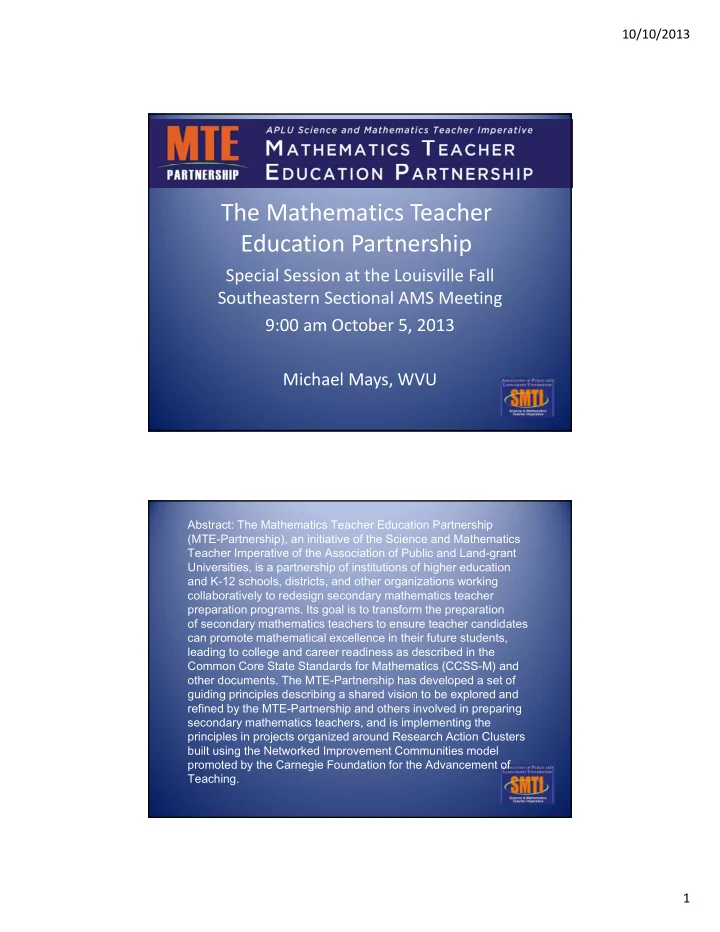

10/10/2013 The Mathematics Teacher Education Partnership Special Session at the Louisville Fall Southeastern Sectional AMS Meeting 9:00 am October 5, 2013 Michael Mays, WVU Abstract: The Mathematics Teacher Education Partnership (MTE-Partnership), an initiative of the Science and Mathematics Teacher Imperative of the Association of Public and Land-grant Universities, is a partnership of institutions of higher education and K-12 schools, districts, and other organizations working collaboratively to redesign secondary mathematics teacher preparation programs. Its goal is to transform the preparation of secondary mathematics teachers to ensure teacher candidates can promote mathematical excellence in their future students, leading to college and career readiness as described in the Common Core State Standards for Mathematics (CCSS-M) and other documents. The MTE-Partnership has developed a set of guiding principles describing a shared vision to be explored and refined by the MTE-Partnership and others involved in preparing secondary mathematics teachers, and is implementing the principles in projects organized around Research Action Clusters built using the Networked Improvement Communities model promoted by the Carnegie Foundation for the Advancement of Teaching. 1
10/10/2013 Background on the partnership • 185 member institutions – leading public/flagship/land ‐ grant research universities in every state • 27 major university systems • Largest well prepared undergraduate cohorts in science, engineering and mathematics • Largest set, among most accomplished science, math and engineering faculties 2
10/10/2013 SMTI ‐‐ • Initiated in 2008 by the Association of Public and Land ‐ grant Universities (A P L U) • Now a partnership of 131 public research institutions, 13 university systems across 44 states • Collectively prepare over 8200 mathematics and science teachers annually • Public IHEs in 40 of the states that have adopted Common Core State Standards for Mathematics • Selected partner for 100Kin10 (2011) • Developed an Analytic Framework to understand current teacher preparation programs (2009 ‐ 2011) 3
10/10/2013 General Goal To transform the preparation of secondary mathematics teachers to ensure they can promote mathematical excellence in their future students, leading to college and career readiness as described in the Common Core State Standards for Mathematics (CCSS ‐ M). Goals • build a national consensus on guiding principles underlying secondary mathematics teacher preparation programs; • promote partnerships (local, state, and national) focused on improving secondary mathematics teacher preparation; • develop and coordinate a networked research and development agenda; • serve as a clearinghouse for model programs and practices; and • advocate for changes in policies around secondary mathematics teacher preparation. 4
10/10/2013 Timeline • November 2011 – Call for applications for partnership teams to join MTE ‐ Partnership: – A lead university involved in APLU/SMTI – At least one K ‐ 12 institution – Other institutions and organizations focused on preparing secondary mathematics teachers (other colleges and universities, community colleges, regional inservice centers, …) 38 partnership teams 68 universities 9 community colleges 87 school systems 30 states 5
10/10/2013 • Partnership Conference – March 25 ‐ 27, 2012 in Atlanta, Ga. – 110 attendees, including mathematics teacher educators; mathematicians; secondary mathematics teachers; K ‐ 12 district mathematics supervisors and coaches; state supervisors of mathematics; … and more! – Provided extensive feedback on “guiding principles” and project design Purpose of Guiding Principles The “guiding principles” form a shared vision to be explored and refined by the MTE ‐ Partnership and others involved in preparing secondary mathematics teachers. 6
10/10/2013 I. Partnerships Guiding Principle 1. Partnerships as the Foundation Guiding Principle 2. Commitment by Institutions of Higher Education Guiding Principle 3. Commitment by School Districts and Schools II. Teacher Candidate Knowledge and Skills Guiding Principle 4. Candidates’ Knowledge and Use of Mathematics Guiding Principle 5. Candidates’ Knowledge and Use of Educational Practices III. Support Structures Guiding Principle 6. Clinical Experiences Guiding Principle 7. Student Recruitment, Selection, and Support Guiding Principle 8. Beginning and Inservice Teacher Support Guiding Principle 9. Tracking Success Timeline • Formation of Working Groups – Partnership teams invited to join in July 2012 and started work in early September – Topics for the groups were chosen to represent high ‐ priority interests based on initial discussion from the Conference and subsequent input from partnership teams – Groups have focused on: • Defining the problem – what are the causes? • Identifying potential measures and interventions. 7
10/10/2013 I. Building a common vision. (three partnership teams, eighteen people) Guiding Principles 1,2,3: Partnerships as the Foundation • Commitments by Institutions • of Higher Education Commitments by School • Districts and Schools II. Preparing and supporting mentor teachers. (eight partnership teams, 31 people) Guiding Principles 6, 8: • Clinical Experiences • Beginning and Inservice Teacher Programs 8
10/10/2013 III. Improving mathematics content preparation (ten partnership teams, 54 people) Guiding Principles 4, 5: • Candidates’ Knowledge and Use of Mathematics • Candidates’ Knowledge and Use of Educational Practices IV. Recruiting and retaining teacher candidates (four partnership teams, 20 people) Guiding Principles 7, 9: • Student Recruitment, Selection, and Support • Tracking Success 9
10/10/2013 DESIGN FOR RESEARCH AND DEVELOPMENT (SECOND CONFERENCE, JUNE 7 ‐ 9 2013) Networked Improvement Communities (NICs) • Model developed by the Carnegie Foundation for the Advancement of Teaching. • Seminal paper by Anthony Bryk, Louis Gomez, and Alicia Grunow: “Getting Ideas into Action, Building Networked Improvement Committees in Education.” • Ideas put in place in Statway and Quantway Network projects. 10
10/10/2013 Aspects of Networked Improvement Communities (NICs) • Rapid prototyping • Root cause analysis • Driver diagrams Root cause analysis for MTE ‐ P 11
10/10/2013 Preliminary driver diagram Research Action Clusters (RACs) Clinical Experiences Building Communities/Courses Actively Learning Mathematics MATH: Marketing for Attracting Teacher Hopefuls Knowledge ‐ For ‐ Teaching ‐ Mathematics Tasks (KTMT) 12
10/10/2013 • Support from NSF for planning, first conference • Support from Helmsley Trust for planning, second conference • Support from Helmsley Trust of $1.05 million dollars for Hub functions, launch of Action Learning RAC Contact • W. Gary Martin wgarymartin@auburn.edu • Howard Gobstein hgobstein@APLU.org • For more information www.MTE ‐ Partnership.org 13
Recommend
More recommend